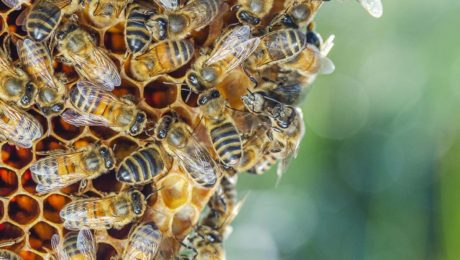Estimated reading time: 2 minutes
A gaggle of geese, a herd of cows, a pack of wolves, a cluster of bees…. it’s all semantics.
Honeybee Cluster
What is the cluster size? This is a common question you may hear among beekeepers when discussing the size of a honey bee colony. The honeybee cluster is the main brood area of the hive. Here the queen will lay eggs and the nurse bees will feed the young. Honey and pollen will be stored nearby for ready access. The cluster area is the “heart of the hive”, especially in winter.
Most of the year, the honeybees will be spread out over the frames going  about their daily chores. But the arrival of cool weather forces the bees to begin the clustering behavior. Because of the rearing of young, the brood area must be kept warm. When brood is present the temperature at the center of the honeybee cluster will be near 94 degrees. The bees produce heat by moving their wing muscles. As you move toward the outside of the cluster the temperature will drop. When the weather gets colder, the bees cluster tighter together.
about their daily chores. But the arrival of cool weather forces the bees to begin the clustering behavior. Because of the rearing of young, the brood area must be kept warm. When brood is present the temperature at the center of the honeybee cluster will be near 94 degrees. The bees produce heat by moving their wing muscles. As you move toward the outside of the cluster the temperature will drop. When the weather gets colder, the bees cluster tighter together.
Most beekeepers want a large cluster of bees going into late Fall. Throughout the winter, some of the older bees will die and the hive population will decrease. We want a colony to have a large enough population to sustain some loss before new bees begin to appear in late winter.
Genetics also plays a part in cluster size. Some strains of bees (such as Russians or Carniolans) will carry smaller clusters into winter and then expand the brood nest rapidly upon the arrival of early Spring.
When bitter cold weather arrives, the bees will not leave the cluster to bring honey close by. If the cold weather continues until the honey supply near the cluster is exhausted – the bees will die. This is especially a danger to small clusters. So, a honeybee colony can perish even when they have a full super of honey on top or several frames away. The honey stores have to be in the right place at the right time.
We wish the very best for all of our beekeeping friends and their bees during this winter weather!
This is a great time of year to prepare new equipment for Spring. We have everything you need: order here
Are your bees ready for cold ?
Artic cold is on its way. Are your bees ready for cold ? All local beekeepers will be watching the temperatures in the following days and hoping that their bees are alive and well. Honeybees store honey to eat during the winter and generate heat for survival. If the bees are unable to store enough food, most beekeepers will supplement by feeding them sugar water. All of these activities need to be completed before the bitter cold arrives. Having the bees ready for cold before it arrives is the key to success.
Want to know how the hive keeps warm ? Click here
In our area, if we try to heat the hive we may cause more problems than we solve. Bees inside a warm hive would want to fly out. They will not survive very long in the cold temps and usually end up dead on the ground. Our best plan is to make sure they have food inside near the cluster and hope they will be able to withstand a few cold days. We are lucky to not experience long periods of bitter cold in South Carolina.
Beekeepers are an inventive group of folks. Some will place dry sugar inside the hive for an emergency feed. Others make candy boards well in advance of winter. In the south, some beekeepers feed sugar syrup during the warmer days of winter. Various candy/sugar feeding options
We all have the same goal. We want to get the hives through the coldest part of winter and look towards Spring.
We hope everyone’s bees survive this artic blast !



